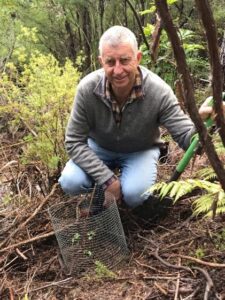Potting up event attendees – how are their seedlings going?
The Biodiversity and Restoration Group were curious to know how all the little seedlings that were potted up at their various potting up events this year and last year were doing. So they sent a survey to all of those who’ve attended these events.
Marieann Keenan and Paul Kennedy who attended a potting up event responded and sent us through some photos. They’re pictured here with their seedlings planted out. Marieann and Paul potted up about 60 seedlings including ribbonwoods, beech, tōtara, pittosporums, an coprosma. Marieann commented:
“Two thirds are in the ground. We lost a few seedlings in their root trainers over summer despite watering them frequently but they are doing well since we planted them out in June. The majority have survived. When they are big enough, we are planting them out over a hectare of our private land which adjoins the Otuwhero Estuary. The area has many streams that are vital to the health of the ecosystem. We are trying to remove invasive weeds, restore native plants and retain land adjacent to an estuary that has been damaged by sediment and forestry activities. Our planting efforts will enhance these waterways and the bird and insect life.”
Here’s a rundown of how many and what sort of seedlings the four who responded in addition to Marieann to the BAR survey took, which amounts to a total of 650 seedlings.
- approximately 100 – Lemonwood, Manuka, Wineberry, Five Finger, Rata, Totora, Kahikatea, Grasses,
- around 150 – kanuka, five finger, tī kouka, putaputaweta, etc
- Phew blimey about 350 – red beech and putaputaweta
- 100 – a mix of rimu, totara, ake ake, grasses and flaxes
The BAR group were happy to read about the good survival rates all round. Here’s what seedling growers said:
- Very good survival and the quicker growing trees have grown rapidly and have been transplanted over the last month
- They are all looking really good. Growing in a shade house, kept watered over the winter. Have planted some of them out already.
- They are growing well – not quite ready to plant out this year. I prefer them to be well established as they mostly go into an area that easily is inundated with water so they need to be a bit sturdy to withstand water flow – have already had to stand up previous plantings this year when we last had a lot of rain in June. We did lose a few in the dry summer – they were quick to dry out despite being in the shade.
- all planted up in root trainers, in shade area or under bananas over the summer, all very healthy
- They are growing really well in their trays. They are growing in a shade house on the bench in 2 long trays of potting mix, and kept moist. I think the majority of them have survived and will likely need potting on again soon as they get bigger
These are the sorts of areas the plants are destined for, all about improving environmental health:
- They are in a native wood lot that is a fenced off wet land.
- We are planting out a lot of banks and wet areas. We are hoping that by cleaning up our creek and replanting the banks and re-establishing some water ways, that this will improve the water leaving our property that is heading into the Motueka River.
- Ours are being planted around a forest remnant that has a QE2 covenant, and beside the Waiwhero Stream. Aiming to provide shade for the Waiwhero as it mostly has just grass/weeds alongside – looking to protect the water quality and enhance it as an environment for wildlife
- Planting within a QEII area, next year
- I will plant them out into regenerating forest that we are creating at our property. We live on a hillside with a stream at the bottom of the hill
Well done to all of our superstar plant growers!! What an awesome effort keeping your babies growing and healthy and helping the environment and our freshwater in the Motueka catchment and catchments nearby.



